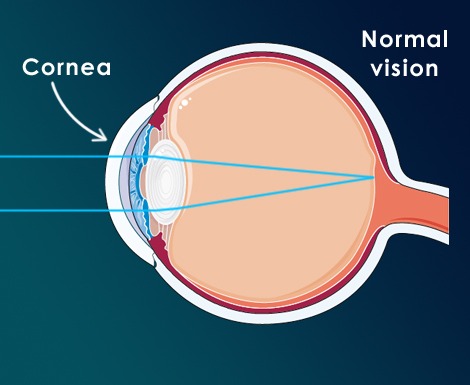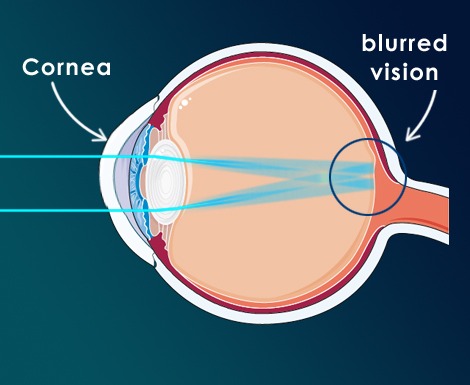What is astigmatism, How is it corrected
Unveiling the "Cylindrical Eye Numbers": A Tale of Clear Vision
Imagine a world where everything looks slightly stretched, blurry, or distorted, as if you're constantly viewing life through a funhouse mirror. For millions, this isn't a whimsical thought, but a daily reality caused by something called "cylindrical eye numbers." This isn't a mysterious code, but rather a crucial component of an eye prescription that signifies the presence of astigmatism. Let's unravel this fascinating aspect of vision and explore the paths to clarity.


Our journey begins with the eye itself, a marvel of natural engineering. Ideally, the cornea—the clear, outermost dome—and the lens inside should be perfectly spherical, like a basketball. This allows light to enter the eye and focus precisely onto a single point on the retina, the light-sensitive tissue at the back of the eye, creating a sharp, clear image.
But what if, instead of a basketball, your cornea or lens is shaped more like a football or the back of a spoon? This irregular curvature is the essence of astigmatism. When light hits this uneven surface, it doesn't bend uniformly, scattering across multiple focal points on the retina. The result? Blurred vision at all distances, ghosting, streaky lights, and often, an annoying sense of eyestrain and headaches from your eyes constantly trying to compensate.




This is where "cylindrical eye numbers" come into play. On your eye prescription, you'll see a column labeled "CYL" (for cylinder) and another for "Axis." The cylinder number, measured in diopters (D), tells your eye doctor the amount of astigmatism you have. A higher number, whether positive or negative, indicates a greater degree of corneal or lenticular irregularity. The Axis number, ranging from 1 to 180 degrees, specifies the orientation of this uneven curve, much like the angle of the football's tilt. Together, these numbers precisely map out the unique distortion in your eye.
The good news? Living with this distorted view is largely a thing of the past. For many, the simplest solution is eyeglasses. These incorporate special cylindrical lenses that counteract the eye's irregular shape, bending light in just the right way to focus it onto the retina. It's like adding a perfectly shaped piece of glass to complete the puzzle.


But what about the convenience of contact lenses? Absolutely! While standard soft contact lenses won't do the trick, specialized lenses called toric contact lenses are designed specifically for astigmatism. Unlike regular contacts, toric lenses have different refractive powers across their surface and a weighted or thicker zone to ensure they stay in the correct orientation on your eye. This precise positioning is crucial for clear vision, and modern toric lenses offer remarkable comfort and visual acuity. They are available in various wear schedules, from daily disposables to monthly options, providing flexibility for different lifestyles.
For those seeking a more permanent solution, LASIK surgery is often a viable option. LASIK, which stands for Laser-Assisted In Situ Keratomileusis, reshapes the cornea using a precise excimer laser. The laser treatment effectively smooths out the "football" shape, allowing light to focus properly. LASIK for astigmatism has a high success rate, with many patients achieving significantly improved vision and reducing or even eliminating their reliance on glasses or contacts.
However, not everyone is a candidate for LASIK. Factors like corneal thickness and the stability of your prescription are carefully evaluated. For instance, some advanced procedures like SMILE eye surgery can correct cylindrical numbers up to -5D. Here, "D" stands for Diopter, the unit of measurement for the refractive power of a lens. A value of -5D indicates a moderate to significant degree of nearsightedness (myopia) combined with astigmatism. SMILE, or Small Incision Lenticule Extraction, is a minimally invasive laser procedure where a small, lens-shaped piece of corneal tissue (lenticule) is created within the cornea and extracted through a tiny incision, thus reshaping the cornea without creating a large flap.
For individuals with thin corneas or very high prescriptions where LASIK or SMILE might not be suitable, other options exist. PRK, or Photorefractive Keratectomy, is another type of laser eye surgery that reshapes the cornea, but unlike LASIK, it involves removing the outermost layer of the cornea (epithelium) before applying the laser. The epithelium then grows back naturally. While PRK has a longer recovery period and more initial discomfort than LASIK, it can be a safer alternative for some patients.
Beyond laser correction, implantable lenses, also known as Phakic Intraocular Lenses (pIOLs) or Implantable Collamer Lenses (ICLs), offer another powerful solution. These are small, biocompatible lenses surgically placed inside the eye, either between the iris (the colored part of your eye) and the natural lens, or just in front of the iris. Unlike laser procedures that reshape the cornea, implantable lenses work by adding an additional lens within the eye to correct refractive errors. They are particularly beneficial for individuals with very high degrees of myopia or astigmatism, or those who are not candidates for laser surgery due to thin corneas or severe dry eyes. A key advantage of implantable lenses is their reversibility; if needed, they can be removed or replaced. They also preserve the natural corneal tissue, which is a significant benefit for some patients.
In essence, those "cylindrical eye numbers" on your prescription are not a cause for alarm but a detailed blueprint for restoring crisp, clear vision. Thanks to advancements in corrective lenses and surgical techniques, the distorted world of astigmatism can be transformed into a vibrant, in-focus reality. If you suspect you have astigmatism or are curious about your options, a comprehensive eye exam with an ophthalmologist or optometrist is your first and most important step towards seeing the world with renewed clarity.
